Unathi
| Unathi Lore Pages | ||
|---|---|---|
| Planets and Systems | Moghes · Ouerea · Uueoa-Esa · Notable Unathi Colonies · Gakal'zaal · Tret | |
| Factions | Izweski Hegemony · Unathi Guilds · Unathi Piracy · K'lax in the Izweski Nation · The Queendom of Sezk-Hakh · Free City of Vezdukh · Unathi in Dominia | |
| History | Unathi History · Contact War · Unathi Recent Events · Notable Unathi | |
| Religions | Sk'akh · Th'akh · Aut'akh · Si'akh | |
| Society and Culture | Unathi Entertainment · Unathi Honor · Unathi Military Structure · Unathi Crime And Enforcement · Unathi Educational Institutions · Unathi Spaceflight · Unathi Abroad · Zandiziite Games | |
| Regions of Moghes | Izweski Heartland · Tza Prairie · Southlands · Broken Coalition · Torn Cities · Zazalai Mountains · The Wasteland | |
| Lore Arcs | The Titan Rises Arc | |
| Unathi |
| U. Sapiens / Sinta'Unathi |
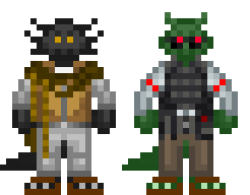 |
| Home System: Uueoa-Esa |
| Homeworld: Moghes |
| Language(s): Sinta'Unathi |
| Political Entitie(s): Izweski Nation / Izweski Hegemony |
Overview
The Unathi (direct plural: Unathi – You-NAWH-thee both singular and multiple) (adjective: Unathite - You-NAWH-thit) are a race of tall humanoid reptiles standing from six to seven feet tall on average, with females slightly smaller in stature. They possess a mixture of snake-like and crocodile-like features, resulting in hard and plate-like scales. Unathi live in their home system of Uueoa-Esa with their homeworld being Moghes. The planet's history can be summarized as being divided up between various Hegemonies, names they give the most powerful Clans on Moghes throughout time. The Clan system is deeply entrenched in Unathi society with everything else revolving around it. It forms a major part of their code of honor, which stresses the importance of martial abilities and loyalty to the Clan.
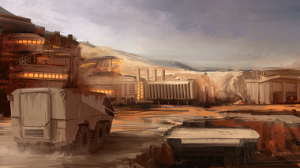
Religion and spirituality play a major role in a Unathi society, and religious differences are the main dividing factor. Conflict between the Sk'akh Church and the Th'akh Assembly, as well as the various communes and cults, have caused conflict and wars between the Izweski Hegemony and the kingdoms that eventually comprised the Traditionalist Coalition. This conflict hit a peak when they entered the intergalactic stage, which is now known as the Contact War. After this conflict, some Unathi fled the planet through Hephaestus or NanoTrasen shuttle ports. Unathi fleeing to megacorporations like NanoTrasen find themselves working in security and engineering roles, but recently many have been proving themselves as competent surgeons and brilliant scientists, earning opportunities that Moghes would deny them because of its strict feudal hierarchy. However, others are slipping through the cracks and becoming slavers, raiders, or pirates. As the ability for spaceship construction increases in the Unathi home system, so too does space piracy and smuggling.
Moghes has two fiercely different biomes after the Contact War. The fertile Untouched Lands with its great jungles, vast swamps, and lush forests; all of which are protected by massive terraforming equipment kept secure by the Hegemony's wealth and power. Contrast to that are the bombarded Wasteland kingdoms in the ashes of plains and forests, burnt into a massive planet-spanning desert rampant with punished kingdoms raiding to survive and part scavengers living in cities on treads.
To apply to be Unathi, apply here.
Heads of Staff
Unathi can be the following Heads of Staff:
- Head of Security
- Chief Medical Officer
- Head of Personnel
- Research Director
- Chief Engineer
- Consular Officer
- NanoTrasen Corporate Liason
The following groups, however, cannot be Heads of Staff: Aut'akh, Guwan, and Gawgaryn of The Wasteland.
Outside of consular officers, command characters should not be of the same clan as any notable lords of the Hegemony. The most prominent clans, such as those of Overlords and the Hegemon himself, are off-limits for command.
Mechanics
Mechanical differences from humans and unique emotes listed below:
Passive
- Unathi are coldblooded which allows slightly improved heat resistance, but increased sensitivity to cold.
- Unathi have claws, which slash and improve unarmed melee attacks.
- Unathi are incapable of easily digesting alcohol, and ethanol is considered toxic to them.
- Unathi can only drink alcohol from drinks with butanol instead of ethanol. Butanol gets them drunk similar to ethanol but has no effect on other species.
- Unathi get no nutrients from eating fruits and vegetables. They need meat to fill their hunger.
- Unathi can safely eat carp and consume carpotoxin.
- Unathi have the fastest sprint available to any species, but they have low stamina, meaning they can only sprint in short bursts. They also are slower than most other species.
Active Abilities
- Unathi can devour monkeys, rats, spiders, carp, and other small mobs by clicking and dragging from the mob to themselves. The animal must hold still for it to work.
- Unathi hiss when speaking Tau Ceti Basic. You achieve this by typing multiple s's during speech. This can also be pronounced through x's if their accent is thick. "Thisss issss an ekssample." You can also Toggle-Auto-Hiss to do this for you.
- Unathi can sample the air with their tongue.
- Unique audible emotes: *hiss, *hiss2, *bellow.
Biology
Their average life expectancy is around sixty years for most Unathi. However, they tend to live for well past sixty years when given advanced medical care available to the other space-faring species. As a cold-blooded species, they suffer fatigue and even short comas when exposed to extremely low temperatures.
Humans and Unathi share a lot of similar internal biology with some notable exceptions. Since they are a carnivorous species, their diet mostly consists of meat and animal products, though they do have a tolerance to some plants and fruits. While Unathi do receive minor benefits for eating certain fruits, they do not get any nutrition from plants. Due to their carnivorous nature, they also have an increased stomach capacity to help eat larger meals at a time. The typical Unathi usually only eats one meal a day, and for the poorer sinta, perhaps once every two days. They tend towards lethargic and sluggish movements more often than not because of their evolutionary history, so they move slower than most organic species. However, the cyclical period of work for Unathi compared to other species is much faster. Unathi are polyphasic sleepers: creatures that sleep in shorter naps rather than at one time during the night. While they tend towards sluggishness, sinta are often capable of incredible bursts of energy and speed, and their ability to work in three or four hour periods of time compensates for their more sporadic schedules.
The reproductive system of a Sinta'Unathi is very similar to that of Earth reptiles. Females lay eggs, with the average clutch being somewhere between one and three. They have a six-month gestation period, after which they are laid in a humid, warm area. After two months, the fetus is fully developed and hatches from the egg. Unathi are born with their claws and the ability to walk within hours of hatching. A Sinta'Unathi is considered an adult when they are 16 years old.
Physical Appearance
The Unathi as a species show a great deal of variation within body types as well as clusters of smaller physical traits passed down through clans. Facial and body features range in size and shape with some having raptor-like aesthetics, serpentine looks, or a more draconic body. Tail length is often genetic; conversely, tail girth is defined by a Unathi's diet as it stores most of the body's fat— nobles grow some of the largest tails.
Unathi scales are somewhat tougher than human skin, though they shed off sporadically rather than all at once. More vulnerable and hidden spots, such as the stomach and waist, the backs of joints, and inner thighs are all leathery skin and aren't covered in scales.
The typical healthy adult male Unathi weighs roughly 280 pounds. Female sinta differ from males as they generally have a shorter and more rounded snout. The typical healthy Unathi female weighs roughly 250 pounds. Female Unathi grow to about 5'9" to 6'8, while male Unathi grow to about 6'0" to 7'0". Unusual heights tend to be smaller in scale, as the taller a Unathi is, the more likely it will be marred with health problems and not live as long as others.
Both sexes stand on digitigrade legs, with three toes on each foot and a hooked dewclaw, and have clawed feet and hands. They also have very long tongues, typically black or extremely dark red in color, which may stretch up to a foot and a half long and are forked just like a serpent's. In much the same manner as snakes, Unathi can sample the air around them using their tongue. They blink and have tear ducts similar to humans.
Unathi horns do not naturally regrow, and serious damage tends to remain permanent. Ancient recipes using native herbs known as "horn paste" are commonly made and sold by herbalists and can counter cosmetic scratches or minor chipping. More modern synthetic Horn Gel (based on Bone Gel), developed largely by Zeng-Hu Pharmaceuticals, can regenerate an entire lost horn, but it tends to be stratified to the upper classes and noblemen due to cost.
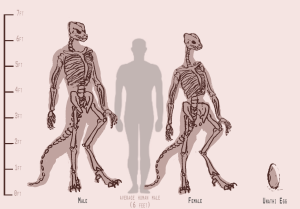
Unathi Coloration
Unathi are also often born into one of four major scale color categories: red, black, orange-brown and "sand-colored", and green. Alternative colors are rare, with dark blue and even albino Unathi being reported in very small numbers. Albinos are sometimes slightly tinted in color while remaining predominantly white. Traditionally these off-colored Unathi are met with prejudice, though some clans outside the Izweski may feel different.
It has been noticed that scale colorations were more represented in some areas than other, and thus, many shades of these colors were, in Unathi culture, named after the places they tend to be seen in more often, in many cases.
- Modern red-colored Unathi are thought to originate from a large nomadic clan that settled South of the Moghresian Sea around modern Skalamar. Nowadays, red-scaled Sinta tend to be seen on the entire Southern coast of the Moghresian Sea and the mountain ranges near it.
- Today’s green-colored Unathi hail from the Southern side of the Moghresian sea, and they are seen more often throughout this side of the coast and down to the colder lands even further South. Surprisingly, there is also a large batch of green-colored Unathi located around Sahl lake, indicating that an old nomadic clan of mostly green Sinta settled there centuries ago.
- Orange-brown and sand-yellow Unathi comprises a wide range of colors. They are a more common color to be seen in a large area, and it is believed that their origins come from displacement in ancient conflicts that forced them to migrate and find new homelands. More precisely, Unathi harboring such colors tend to be more represented in a large area defined between Darakath, Bahard, Mudki, and Yu’kal.
- Black or “dark-scaled’ Unathi do not seem to originate from any precise area, and instead, tend to be more often seen around colder areas of Moghes, both North and South. A popular theory is that black scales are actually a consequence of exposure to the cold for generations— something that has yet to be proven.
All colors, barring albino, do not mix in the traditional sense: if a brown unathi and a light red unathi have a child, the red scales the child has might be a little darker, but the colors do not blend to make something new.
Color ranges
Due to the modernization of Moghes as well as the emigration and population displacement from the Contact War, Unathi of any color can be found nearly anywhere on Moghes. Of course, they are more common in some areas rather than others.
Below are some examples of Unathi scale color ranges. These cover a majority of the colors; while some deviances from these are normal, there are no neon or pink colors among Unathi.
| Usual Unathi color ranges: | 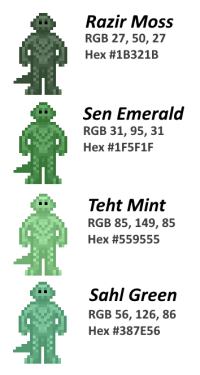 |
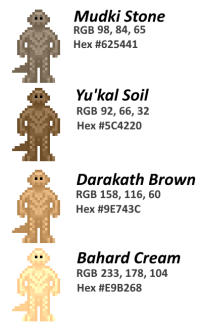 |
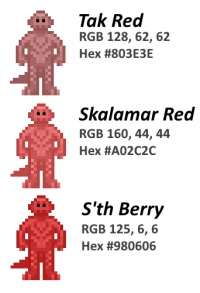 |
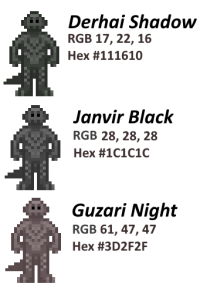 |
|---|
| Unusual Unathi color ranges: | 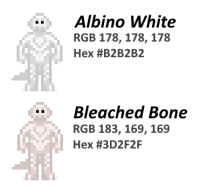 |
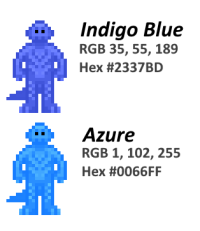 |
|---|
Green:
Razir Moss: RGB 27, 50, 27 / Hex #1B321B
- An unusually dark shade of green, but certainly not the only one, Unathi from Razir and its surrounding areas tend to have this scale coloration more often than not. As the name suggests, it is quite comparable in color to the unique moss that tends to grow on rocks and buildings on the Southern coast of the Moghresian sea. The moss was heavily used by healers in the past, as its spongy nature allows to quickly stop bleeding, and its composition can also help in dealing with infection, or at least, limit their spread, until proper medicine can be found, properties that are quite appreciated in a time like the post-Contact-War era, where shortages, of medicine among other things, aren’t so rare depending of the location. Due to its ties with healing, some of the more traditional Unathi tend to see Unathi with such a scale coloration as more feminine.
Sen Emerald: RGB 31, 95, 31 / Hex #1F5F1F
- Considering the name, and the overall concentration of Unathi in the region, it is assumed that those bearing such coloration came from the now-broken city of Sen. Records of where the name comes from exactly has been lost after the Contact War, but theories still exist with recent finds. The reclaimer clan Kikata, operating a landcrawler by the torn cities, on the western coast of the Moghresian sea, noticed several collapsed mines next to what they assumed used to be villages, and in them, among many other minerals, unique green gems. As word has started to spread, many Sinta are now assuming that Sen Emerald refers to these gems.
Teht Mint: RGB 85, 149, 85 / Hex #559555
- Teht Mint is one of the many crops that (nearly) disappeared after the Contact War and its nuclear fallout. As Teht mostly made its fortune from fishing, nearby villages housed the few clans in all of Moghes talented enough to properly harvest the plant, and who kept such a knowledge secret to all of their own. Used as expensive seasoning by only the wealthiest Nobles in the region, these clans, and their village, quickly made a fortune, then came the Contact war. While the city of Teth was spared by the bombing, the many villages around it that didn’t get outright razed by the nukes were abandonned, as their main source of income, the harvesting of the mint, was soon enough gone and made life there unsustainable, leaving only handful of seeds, currently preserved in Teth’s palace in hopes that they may be planted into proper soil another day. In any case, the name “Teht Mint” persist as a way to call the Sintas bearing a light green scale color that tends to be seen in the area.
Sahl Green: RGB 56, 126, 86 / Hex #387E56
- Lake Sahl, among many other things, was renowned for the unique algae that used to grow in within it, giving it, when the floor was shallow enough, a green-ish tint, something that many local fishers used to call “Sahl’s green halo”. Like many things, these algae died after the Contact War, and the poisoning of the lake due to the ensuing nuclear fallout. Many of the older locals that still remember their time spent fishing in the lake, however, have been continuing to call Unathi living around the lake, bearing a unique shade of green, “Sahl Green”.
Orange-Brown / Sand Colored:
Mudki Stone: RGB 98, 84, 65 / Hex #625441
- The mountainous city of Mudki has been build with the rocks of the very mountains it stands on and between. These rocks exhibit a strange propriety due to their unique composition, something only found in the area, as, when wet, the usually light-grey, or tan stone, turns to a pale-brown. While a small-scaled group of geologists was dispatched to explain the phenomenon, the researches were cut short by the outbreak of the Contact War, and by now, most Sinta simply have their own explanation, from more science-based ones, to some more related to faith. In any case, people have taken to naming the many Sinta bearing light brown scale coloration, around the area, “Mudki Stone”, and some older, more superstitious inhabitants of Mudki and its surroundings claim that these Unathi can, like the stone, change color…
Yu'kal Soil: RGB 92, 66, 32 / Hex #5C4220
- Yu’kal, while far from any of the main lakes or seas of Moghes, was a city that known for its people’s work in aquaculture in smaller bodies of water, natural or, later on, artificial, something that nearby smaller settlements also picked up. While the Contact War and its consequences put an end to such a business, many in the Queendom still remember this time, and how the soil turned damp and darkened from the how humid it could get in some places… Something that led to the naming of the coloration that many of the local Unathi bear, similar shades of brown, “Yu’kal Soil”.
Darakath Brown: RGB 158, 116, 60 / Hex #9E743C
- Darakath Brown, also called “Darakath Copper” by the inhabitants of the once proud capital of the Azarak Kingdom, is ,as the name suggests, a scale coloration mostly seen in Darakath and its surroundings. To the more staunch supporters of the Izweski Hegemony, Sintas with this colors are seen as Traditionalists, and by extent, defeated foes… To others, Unathi with such coloration are treated with kindness, if not (legitimate or not) pity, after the sacking of the city by the end of the Contact War.
Bahard Cream: RGB 233, 178, 104 / Hex #E9B268
- Bahard, before the nuclear exchange, was one of the largest trading hub on Moghes thanks, making a fortune through trading. Beside this, however, Bahard was also known for the culinary expertise of its people, access to food from all around Moghes being one of the reason behind such a thing. Bahard Cream, originally referred to the a seasoning whose recipe was lost by the end of the Contact War, generally offered to passing traders. It was its unique color and popularity that led to the locals, and soon enough, the rest of Moghes, referring to scale coloration seen so often around the area.
Red:
Tak Red: RGB 128, 62, 62 / Hex #803E3E
- Tak used to be a city of relatively modest size, before the nuclear exchange utterly ruined it. Few know why Sinta of this certain shade are thus called “Tak Red”, although researches in Skalamar have led to a theory: fish exports. Most inhabitants made a living through fishing, just like most cities on the coast of the Moghresian sea, although surviving trading records show a higher than average amount of exports from the city. Additionally, texts, and common memory, point that some of the fish unique to Tak’s coast had unique red scales… Although said fishes are extinct by now, everything seems to indicate that this is where the name for this coloration came from.
Skalamar Red: 160, 44, 44 / Hex #A02C2C
- Skalamar Red, also called “Blood Red” by traditionalist and other foes of the Hegemony, is, as the name suggest, more often seen in Skalamar and its neighboring territories. Origins on the name of this coloration were blurry, even before the Contact War, with stories speaking of such colorations having divine origins, from other speaking of a curse, depending of who you ask. In any case, such a coloration is a sign of greatness and valor to some, and of shame and cruelty to some others… Generally depending on who they would have sided with during the Contact War.
S'th Berry: RGB 125, 6, 6 / Hex #980606
- S’th Berries are one of the few species of flora that survived the nuclear fallout of the Contact War… Although, not without consequences. While they were once deep red, the berries lost their color and appear grey-ish; and their sugary taste as been lost, some saying that they now taste like paste instead. Nevertheless, the name given to the color that many Unathi in the area arbor, remained: Unathi of red scales, red like S’th’s Berries.
Black:
Derhai Shadow: RGB 17, 22, 16 / Hex #111610
- Although such a tone can be found a bit everywhere since Derhai’s depopulation, most people can pinpoint that it used to be most often seen in and around great city that stood there, before being abandoned. Due to the highly religious nature that Derhai had, many have been tying (sometimes wrongly) such a scale coloration to Th'akhists.
Janvir Black: RGB 28, 28, 28 / Hex #1C1C1C
- Perhaps a testament to how fast Unathi can evolve and change over generation, Janvir Black is a scale coloration that only appeared around a century after the foundation of the cold metropolis, merely six centuries ago… That is, according to the limited records currently available in the post-Contact War era.
Guzari Night: RGB 61, 47, 47 / Hex #3D2F2F
- There were, allegedly, several small settlements by the coast of the Guzari Sea, despite the freezing temperatures (on Unathi standards, that is), thanks to the unique bounties of the cold Northern Sea. Records seem to indicate, however, that said settlements were abandoned even before the Contact War, something that historians, even to this day, cannot explain, mostly due to the severe loss of historical documents during the conflict. Many Unathi, today, then, see other Sinta with the strange scale coloration known as Guzari Night as quite elusive…
Albino:
Albino White: RGB 178, 178, 178 / Hex #B2B2B2
Bleached Bone: RGB 183, 169, 169 / Hex #3D2F2F
Blue:
Indigo Blue: RGB 35, 55, 189 / Hex #2337BD
Azure: RGB 1, 102, 255 / Hex #0066FF
Albino and Azure (or Blue) Unathi scale coloration are not tied to any area of Moghes, and instead, generally the result of genetic lottery. How such colorations are perceived varies widely. These Unathi would generally face prejudice in the Hegemony, although some other Sinta from different horizons can exhibit interest for them instead, or simply indifference.
Unathi Genetic Variety
Besides scale coloration, many other physical aspects of Unathi bodies can vary widely. From horns and frills, to even extra scale crests and different structures in a Unathi’s very skeleton (namely, the skull). While anatomical differences within a species are natural, Unathi are noteworthy for how wide these differences can get and how fast they come to be. The exact science behind this has been lost after the Contact War, and most of the research behind such a phenomena is idly handled by Nanotrasen and Zeng-Hu specialists. However it is assumed that Sinta simply evolve and adapt to their surroundings much faster than most of the other sentient species of the Spur, leading to such large physical discrepancies between Unathi alone. From this, it is also assumed that, with Unathi populations moving between planets, and Moghes on its way to changing considerably (may the consequences of the of the Contact War be the of the Sinta homeworld, or may terraforming efforts save it), said biological differences between different groups will only get larger and more exotic in the next few centuries.
Genetic Variety
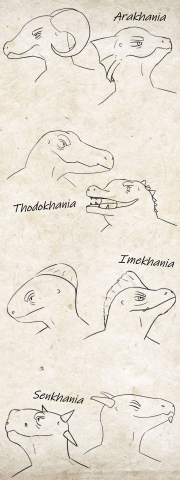
- Horns are not tied to specific places, or at least, not directly. There seems to be a hereditary side to it, however, as Unathi more often than not seem to bear the horns of one of their parents (on VERY rare instances carrying the horns of both). Horns, however, do not “mix” and make new shapes, the same way that Unathi scale colorations don’t mix. Horns are arbored by both male and female Sintas, and can be of various tones, from dark gray, near black, to Ivory or even pristine white, and even in some cases, pale brown-ish tones. Contrary to some belief, Unathi horns are bone, and not made of Ivory or any other precious material. Horn size, just like tail size, also depends on a Unathi’s diet. However, while everyone has the potential to grow an enlarged tail, if given enough fat, horn size highly depends on how well-fed a Unathi is during their childhood as they grow. Coupled with one’s horn’s hereditary nature, it is commonly assumed that A Sinta of noble blood will generally have larger horns… A noble who happens to have shorter horns is generally called a New-Noble, as if they were the first of their clan to ascend to noblehood, and by extent the quality diet that tends to come with it.
- Frills, while hereditary in exactly the same way as horns, tend to be most often seen in Unathi populations living on coasts, or in general humid areas. Frills can be of various colors, so long as they remain in natural Unathi color ranges. They are constituted of either a bony “support”, or in some rare cases, a cartilaginous one, with skin or scales between and on said “supports”. Since frills are articulated, to some minor degree, Unathi bearing frills tend to be seen as more expressive, as they tend to “open” or “close” their frills, accentuating body language. Frills have generally been associated with Unathi of low-to-middle class, or at least, that have ancestry from such classes, as fishermen and such Unathu are generally depicted with large frills. The validity of such a concept is discussed nowadays.
- Crests are rather similar to frills in their constitution, although they differ in the sense that, instead of having a thin layer of scaly hide being stretched between its bony or cartilaginous supports, crests are entirely covered in proper hide. One popular example is the infamous “Cobra Hood” (Which is a domination established by the people of the Spur as a whole, and not by Sinta, as Cobras are obviously not native to Moghes). Like frills, Crests can be articulated, although in a much more limited way. Crests are not limited to any place, and just like horns, are instead fully hereditary. Crests were rather prior to the Contact War, as it was more common among Unathi population living in rather arid areas, earning the rather poetic name of the “Frills of the dry seas”. After the Nuclear exchange, however, new generations born in a changed Moghes start to come with more and more crests already.
- Finally, while minor differences in sizes and shapes can be observed in different Unathi populations, one aspect in particular tends to change drastically: skull shapes. The shape of a Unathi’s head seems to vary widely, with some adopting a more draconic appearance, some being closer to smaller lizards, Iguanas, snakes, crocodiles, etc. The way Unathi see their fellow Sinta with this or that facial appearance varies widely depending on their culture. Once again, both due to migration, populations blending with each other and the loss of records due to the Contact War, locating the origins in Unathi faces has proved to be quite the hard endeavor, but some clues, mostly based on interviews of older, surviving Sintas, have been found, and a proper classification is being reestablished:
- Arakhania (“Draconic”): Arakhanian facial structure, also called “Draconic” in Basic, is perhaps the most well known Unathi skull shape in the entire Spur. Perhaps one of the most well spread facial structures nowadays, it is also known as the “head of the nobles”, due to its prevalence among noble populations, with many notable Unathi arboring such a profile (namely the Hegemon himself). Arakhanians tend to have a pointy snout with smooth shapes, and a frontal bone of varying height and steepness.
- Thodokhania (“Crocodilian”): Thodokhanian faces come with a larger, longer snouts and more flat heads, comparable to Earth’s crocodiles or alligators (hence the name given to such a profile in Basic: “Crocodilian”.) Unathi with the Thodokianian facial structure have turned rarer and rarer since the Contact War, which led to the belief that the nuclear exchange must’ve erased population centers featuring the bulk of their population.
- Imekhania (“Common Lizard-like”): The Imekhanian facial class is as broad as the population it encompasses, being the most represented profile among Sinta. Unathi with the Imekhanian profile come with generally smoother snout shapes and round tips. earning the name “lizard-like” in Basic. According to ancient records and texts, it seems like the Imekhanian profile could be seen everywhere on Moghes, even before the first large population movements…
- Senkhania (“Snake-like”): With their flat heads and short snouts, Senkhanians faces are, as their name in Basic suggests, comparable to Earth’s Snakes. While a small part of the population, Unathi with the Senkhanian facial profile are still considered a category of their own, due to their presence in mostly rural areas (something that has yet to be explained), zones that would tend to not be the direct targets of nuclear bombardment during the Contact War.
- Lokhenian (“Others”): Lokhenian facial profile, or “The faces of the Lost” is an all-new, post-Contact War classification, used to designate any facial structure that does not fit in the other aforementioned categories, and are not large enough to warrant a category of their own. Such facial structures are extremely various but also tend to be extremely rare, and it is assumed, that those were already quite rare even before the nuclear exchange, as they were rarely ever recorded in pre-contact war media.
Afflictions and Disabilities
Unathi, like all species, are prone to conditions that are uncommon among the population. How each Unathi views or handles these is varied due to the traditional cultures of Moghes.
Lsh'islasulu, sometimes shortened to "Lsh disorder," is a rare scale disability affecting very few Unathi. The disorder is poorly studied because of its lacking negative affects and extreme rarity. When suffering from Lsh disorder, Unathi will lose their dead scale cells through a painful peeling process, rather than sporadically. A Unathi suffering from the disorder will need to painfully peel or scrub off their dead scales off once or twice a month in droves. The affliction is caused by increased cell death, and scale cells will die rapidly for no apparent reason. Luckily, this process only causes pain and increased susceptibility to the cold, not causing any damage or making the scales much weaker in terms of durability. Further information is lacking due to little research preformed.
Kaasilik is a famously known yet equally rare disorder inflicting unique symptoms. Those suffering from Kaasilik lack any growth of frills, hoods, horns or any other structure on the head or face. While labled a disorder, those affected by it suffer no physical drawbacks and are believed to be the result of a genetic lottery in which generations of couples between Unathi with certain horn or frill growth reproduce. While undamaging to the Unathi physically, it can make identifying them from another suffering Unathi difficult at times. Children of these Unathi will likely have very small or limited frill and horn growth.
Albinosm, or Zis'lak, caused by a general lack of pigment in the scales, makes the scales appear totally white, sometimes with a minor tint of green, red or sand/orange, caused by a total lack of pigment. Albinism in Unathi can also cause a unique shift in eye color; while typical for Unathi to have colors like orange, red or green, albinism can shift the eye color to an unusual violet. This is due to a lack of eye pigment combined with the light refraction off of the blood vessels within the eye. Unathi that suffer from albinosm usually remain away from sunlight as their sensitive scales provide little to no UV protection and put them at risk of burns. Albino Unathi are also often seen as a bad omen at birth, and as such, those within the Hegemony's lower populated areas are often banished from their clan or in extreme circumstances, even banished from some clans to become Guwan. It should be noted that azure colored Unathi cannot be albino.
Illiz is a disorder appearing in two states with a wide variety of recorded variation. The disability details highly irregular tail size, this can include tails the size of a finger or tails so long they become a tripping hazard. The former being nicknamed, "Hasik." Unathi affected by Hasik typically suffer when sprinting, their short tails also prevent fat storage, which results in the fat being stored elsewhere like the arms, thighs and lower body. The latter mentioned state of Illiz, nicknamed "Hasil," is the complete opposite. Those affected by Hasil find their tails reaching lengths of up to four feet long. Hasil includes similar issues as Hasik, the most notable of which is it also negatively affects balance. Those with longer tails struggle to sprint, carrying the weight of such a large tail. Culturally, those suffering Hasik are viewed as pathetic and as cowards, while those with longer tails are presumed to be a noble. It should be noted that very few nobles have been documented suffering Hasik, while some, using plastic surgery, increase the size of their tails to mimic Hasil.
Religion
While various faiths exist on Moghes, many of which are as old as any other, there are two major religions of the Unathi that pervade nearly every aspect of their lives. Th'akh and Sk'akh, both of which predominately focus on ancestor worship and connections with the spirit world.
Th'akh
The most pervasive and common religion amongst Unathi. It dates back even before the First Hegemony and, as a byproduct of Unathi stubbornness, has remained central to Unathi spiritualism. The basic concept of Th'akh is that all the spirits of past Unathi now reside in the spirit world that exists in tandem with the material world. These spirits exist in objects and nature - bringing either good luck or sorrow. Particularly nasty natural disasters were often attributed to particularly strong groups of spiteful spirits influencing events in the material world. Th'akh, due to its widespread pervasiveness, has a multitude of forms: ancestor veneration, polytheism (worshipping groups of specific and powerful spirits), and almost witch-like spiritualism are just some of the denominations found among this religion. However, Th'akh almost always has the same group of tenets, which can be found here.
Sk'akh
The second most common religion, which is followed mostly by Unathi from the Izweski Nation, and enjoys a status as its unofficial state religion. It still follows the ancestor worship of Th'akh, but with a major notable difference: the spirits of all Unathi who die become part of Sk'akh, the Great Spirit. Sk'akh is a gender-neutral God, being called 'he' or 'she' interchangeably to represent that Ska'kh is a collection of all Unathi. She is often called Three of One because the spirits combine into three minor aspects that are all part of Ska'kh: the Warrior, the Healer, the Fisherman. These three spirits are personifications of the most important aspects of Unathi society. It is said that all three are equally important and that disasters are caused by an imbalance in the Great Three. Priests often stress the importance of balance, both in matters of the spirit as well as in society and personal life. Sk'akh's dogmatic doctrine can be found here.
Aut'akh
Emerging from the hatred of former warriors, the Aut'akh are a cultish offshoot of Th'akh, comprised of cybernetic-augmented Unathi. They argue the flesh is weak, and something new must be sculpted in its place to strengthen the mind. In the relative safety of their communes scattered across various towns, planets, and systems, they know a rough life, but one easier and more spiritual than those of the cities, they believe. The Aut'akh have yet to truly attain their perfect leaderless society, as their own supposedly-defeated prejudice still runs in quiet circles within communes; meanwhile, society often rebukes and ridicules these fanatical trans-speciests. Their lives are gently guided by the shamans or "paradigms," which act as the religious advisors and sometimes too the biomechanical engineers of these communes. Aut'akh preach the Contact War was the result of sinta being so consumed by the demons within them that they brought the world to ruin, and all powers, whether that of a government, major religion, or corporation, are inherently corrupt due to the influence of evil spirits. The heathen's lifestyle and struggles can be found here.
Aut'akh, due to their radical views on unathi society and society as a whole, are often associated with anyone who breaks tradition. In light of this, unathi started to develop behaviors and society learned to hate communes and their denizens. Anyone caught being unfaithful to their spouse, in a non-monogamous relationship, rebuking their clan, having a prosthetic, or even talking about their discontent with the Hegemony or other rulers was accused of being an Aut'akh. The term to most became synonymous with anyone who was a perceived troublemaker or heretic, more so than even Si'akh.
Si'akh
Born from the fires of the Contact War, Si'akh is a radical Sk'akh heresy that has rapidly spread across the Wasteland. It is lead by charismatic former Sk'akh priest Juzida Si'akh, who claims to be the Messiah for all Unathi. The doctrine claims the Contact War to have been the Final Judgement for the Unathi species caused by their innate wickedness. He claims that all Unathi that died in the 'cleansing fire' of the atomic weapons were given salvation, and all Unathi that survived are damned to remain trapped on the Hell of Moghes unless the species and Moghes are rapidly purified. The movement has come into immediate conflict with the orthodox Sk'akh church due to Si'akh claiming it to be completely illegitimate. Its followers are ruthlessly hunted down by the Maraziite Order and many of its followers are fleeing into human space as they try to find personal salvation. Their doomsday cult has strict and ascetic principles to help Unathi obtain a chance at salvation.
Social
Unathi have a variety of behaviors, sayings, and customs that other species would find odd and peculiar.
Language
Unathi, being deeply traditional, tend to use their own sayings, proverbs, and similar speech in other languages not native to them. Some concepts of their languages also spill over into tongues foreign to Unathi. For example, the sexes are so closely tied to their roles in society that words for "man," "male," and other parrot words are practically synonymous with "warrior." The same is said for words like "woman" and "female" with "healer." Objects also have assigned genders to them, so it is not uncommon for sinta to refer to objects and inanimate things with genders. Unathi also have a lot of assorted figures of speech that, instead of being based on direction (up and down), are affiliated with time and its speed. A faster rate of time is seen as bad while a slower rate is seen as good in a majority of cases. Good things are categorized by saying something is punctual, progressing on time, is speeding up in time, or has a lot of time while saying the opposite for bad things. Rather than saying "I’m going to bed for the night," a Unathi might offer "I’m slowing down for the night"; similarly, instead of being "down to hang out," one would instead say they "want to slow down" with someone else. Examples include, but aren’t limited to: "today’s harvests were timely," "the day has been slow," "my body is slowing," "their sleep is running late," "I’m accelerating through my studies."
Unathi names are extraordinarily diverse, ranging from those that string together a bunch of consonants to sounds with many vowels in a row. There are not many commonalities between them besides harder sounds like 'ck,' 'zh,' 's,' 'd,' and 't.' However, names cannot have more than two of the same letter in a row, such as Myo'sssak.
Many species have developed the joking term "unathisms" for all the various cultural holdovers that get put into other languages they speak.
Unathi Metaphors, Sayings, and Slang
Claws, talons— fingers, nails, respectively; however, sometimes satire or exaggeration make use of them interchangeably.
Hatchling, egg— a child or baby, sometimes also as an insult.
Azure, albino— exotic, or unusual; alternatively (and rarely), an archaic and outdated way of calling something awful: "Their tastes are absolutely albino."
Hide, scales— skin.
Rattle, rattled— scared.
Scratch, scratched— to write/written.
Tailwag— generic insult lacking true meaning and has a weird versatility to it, like referring to someone as a 'fuck' or similar.
Blood on my teeth— eating, sometimes a gruesome (seen as barbaric) way of describing fighting and other activities.
Lay down my tail/bare my neck— let someone walk over you.
Molting— getting angry enough over something that it damages your physical health. Used almost explicitly for exaggeration.
Fat-tail— an insult usually aimed at nobles.
Quote a limerick— to be sassy, snarky, witty.
Grinding my horns— getting on their nerves.
Strum— gather.
Stomp, stomping— a get together (as a noun) or referring to someone being happy (as a verb).
Echoed song— oral tradition.
Ghazkus, ghazkii— skrell, coming from the word "amphibious" in Sinta’Unathi: ghazii.
Kzlth, kzlthii— humans, coming from the word "scaleless" in Sinta’Unathi: kazulth.
Imiekran, imiekranes— the typical term for dionae meaning "twisted plant" in Sinta’Azaziba, usually a term of endearment; alternatively called aggregates when referring to different forms.
Xsain— vaurca, coming from the word "incomprehensible" in Sinta’Unathi: xsa.
(Note: most of the time this is seen as being a nickname when used outside of Sinta’Unathi or Sinta’Azaziba. If you are particularly friendly with someone that either you don’t know the name of or are referring to someone otherwise, this may be appropriate outside of saying the species’ name.)
Zo’zyola— the equivalent of an angel or a demon. Depending on the context, this is either a compliment or a severe insult.
Dishonored their clan— do something to ostracize themselves from society or a group of people.
A tale longer than my own— a play on words gaining traction among Sinta who speak Basic. Basically a way of saying "it's a long story" with similar connotations, but this phrase can also be used to hype up an event. "What did you do during the Solarian Invasion?" "It's a tale longer than my own— let's meet up to discuss it."
Heating up— a way of setting your guard is going down or that you are even getting bored or tired. "This shift has been uneventful, I can feel it heating up."
Sk'akh's scales— a way of saying "holy shit" or similar swears.
Have an honorable duel for the sake of the game— in Sinta'Azaziba and Sinta'Unathi, duel and game are the same word, just with different meanings. This is a play on words in the original tongue and is meant to talk about something that has to be done yet trying to make fun out of it anyway.
More unclean/unkempt than a Guwan's feet— referring to something being worse than the dirtiest part of a class of undesirables. Phrases like these are more common in the Hegemony and are one of the many methods used to degrade Guwan.
When an arbek eats its tail— "when pigs fly."
Preparing the maxtlatl— referring to the shaman's garb. Preparing the maxtlatl is something a shaman does when they feel they are near death; in preparing it, they are readying the skull in the headgear to be replaced by their own. In a sense, if someone is preparing the maxtlatl, they are spelling their own doom or see their demise coming.
By the Fourth Nation— somewhat of a joke about cycles, playing fun at the fact that the Izweski Hegemony has been a constant throughout history. Traditionalists use this phrase more bitterly and sardonically, however.
By mine and your spirits— a way of solemnly swearing; alternatively, asking for guidance if you worship Th’akh.
Three Heads bless me— the alternative to "by mine and your spirits" for those that worship Sk’akh.
Bet the Hegemon’s head— many people want to kill the Hegemon, so this refers to such a bounty. Usually used as a joke or a dare.
Individual languages are described by the prefix 'Sinta' followed by the identity of its native speakers. Speaking mannerisms remain the same when speaking Sinta or another language. For stylistic choices, there are some options. For those raised in or by the Hegemony, avoid contractions like it's and they're, which would be it is and they are. Formal Sinta'Unathi lacks this concept of contracting words, and thus it is a difficult concept to understand for these speakers. Those that speak Sinta'Azaziba will talk in other languages in short bursts, similar to how Azaziba has shorter sentences due to gesticulating and speaking at the same time. Accents are wide and diverse; replacing 's' sounds with 'th' in a 'forced lisp' or even just omitting the sound is a commonality for Unathi that struggle with certain words in other languages (like 'suspicious'). This way of speaking is also common when singing in different languages, a trend picking up within the Izweski Hegemony.
Sinta'Unathi
While Pre-Contact Moghes had hundreds of unique languages and their own histories, Sinta'Unathi has been and remains the primary language spoken by most Unathi. It is an evolution of an older Moghean trade language, Sinta'Izwe.
The written language has 30 letters, with 5 of them being vowels. The language is written left to right, though this was an attempt to emulate humanity, as informal Sinta'Unathi still write top to bottom.
Sinta'Azaziba
Sinta'Azaziba is a language of Moghes consisting of a combination of spoken word and gesticulation. While waning since Moghes entered the galactic stage, it enjoys popular use by Unathi that never fell to the Hegemony's cultural dominance. Sinta'Azaziba writing has 27 letters, 4 of which being vowels. The language is written from top to bottom.
Social Behavior and Mannerisms
Unathi generally stare at what they are interested in, so their intense gaze moves with a conversation to whoever is talking. Additionally, pointing can be seen as extremely rude in circumstances. If more than just a passing gesture towards someone, prolonged pointing can be a grave insult to one's honor and, in some cases, be the reason for crude fighting or even initiate a duel.
Unathi should always be addressed by their last name in most situations. It is offensive to use a Unathi's first name unless you are family or have a close relationship with them (like family, a lover, or close friend). Some are more permissive than others regarding this. In a situation where there are multiple Unathi with the same last name, it's generally accepted to just get more and more specific in your address to make it clear who you are speaking to.
Unathi to other species would typically appear sluggish in their movements, though there are some exceptions to this. When working or even when feeling threatened, they typically move short distances with their arms and legs at speeds much faster than normal for other species. This is because they conserve their energy by going slightly slower until they need it for a given task.
Another outstanding behavior that other species would note is an intense gaze. Unathi typically find staring at whoever is speaking to be respectful; however, this intense staring, paired with not blinking often and stooping to look at someone at eye level, is how other species are typically made uncomfortable when engaging with Unathi.
For most Unathi being seen speaking to Guwans is embarrassing. A woman associating with a Guwan is extremely improper and indecent, and they can lose social standing by doing so.
Violence can have its place in regular daily life, with playful fighting being commonplace with the peasantry and in the Wasteland. Joking punches and wistful tail flicks that would be normal for Unathi playing around may end up hurting a human, which has led to many jokes about humanity’s weak stature. Shoulder checks and headbutts have their place in more aggressive friendships and is a sign of showing brotherly love.
Emotional Displays
Unathi exhibit a great variety of emotional body language in ways different from other species. While it is not uncommon for Unathi to attempt to mimic human displays (sometimes with frightening results, for example showing off their large, numerous sharp teeth in a "smile"), they have their own natural, basic emotions that come from biological expression akin to reptiles. It can be very difficult for this species to control their emotionally-linked body language as it is engrained in Unathite culture, but exercising restraint is often seen as a sign of nobility or simply an individual who is attempting to better blend in with other species. Over time, these displays can also change to adapt to a different environment, though this process typically takes many years to come to fruition.
For example, baring the entire throat is the single most meaningful expression that can be displayed to another, often used to show trust or vulnerability to someone a Unathi cares about. However, it is not unusual to do this to also surrender to another (such as in a fight), admit shame, or display extreme compassion (when exposed to twine necks with another). Conversely, tilting the snout far down to protect the throat and better display one’s horns is a fight response or to show distrust in another.
When it comes to intimate gestures between Unathi, they usually twine necks or tails, and touch foreheads and snouts together with the same intent that humans kiss. Such displays are usually only reserved for those that are married or to be wed, but with other cultures such as Ouerea, the smaller colonies, or the Empire of Dominia, this tends to be much more relaxed. Hugging is usually considered to be something done by children and avoided by adults.
Unathi often fixate on their surroundings when interested or excited by someone or something. If there is a conversation of multiple people, they often change their gaze to look at whoever is speaking, or at the person speaking they are most interested in. It is considered rude by Unathi to avert your gaze, for that shows that someone can be aloof, distant, or not paying attention fully. Even if afraid and cowering, they tend to look directly at the source of their fear. For other species, when especially happy or interested, they can even stoop down to look at them directly at eye level, or try to raise themselves as much as possible to look other creatures in the eye.
Other physical displays include the ‘tail stomp,’ a phenomenon common during heightened signals of emotion. Typically, these are done when a sinta is filled with joy or extremely agitated, but can be rarely used when a Unathi is grieving. Other more minor displays are, but aren’t limited to: bristling scales, in response to a cold environment or a ‘chill going down their spine;’ becoming slow and sluggish if extremely comfortable, such as reacting to warmth; swaying, sampling the air, and hissing all are common when in a new environment, with strangers, or even just in certain situations, which shows curiosity, discomfort, or unease.
Verbally, Unathi have some onomatopoeias that they draw on for different emotions. Chuffing, forcefully exhaling air from the throat, can be used to mark mild annoyance in reply to something, or can be used to show amusement. If it comes at the end of a sentence or statement, it can imply that they are being sarcastic or are saying something in good humor. Unathi don’t quite have a laugh; instead, they bark in typically short bursts, in which the sound is often deep, loud, and raucous. Finally, rattling the throat is a fairly common gesture that replaces or accompanies a tail stomp. Sometimes when enraged, throat rattling is accompanied by frills or scales flaring up as well.
As a result of the divide between groups of sinta, some mannerisms are unique to different social groups. For example, nobles tend to tail stomp in response to seeing something that ‘disgusts’ them, whether it be the sight of a heretic or Guwan, something that disgusts olfactory senses, or something else. Peasants on Moghes and most Unathi on Ouerea tend to be ‘overly emotional’ in that they often tilt their snout up somewhat when showing general content or happiness, or down slightly when afraid or unhappy. Dominians often keep their chin tilted up constantly as a sign of pride and even cockiness, showing they aren’t afraid when vulnerable parts are exposed. Of course, this all barely scratches the surface, and there are many gestures unique to cultures and regions that are not enumerated.
Society
Moghean
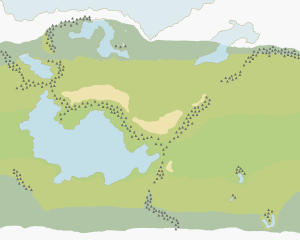
Moghean Unathi are traditional Unathi with the planet being their homeworld. Historically culture varies across clans that exist on the planet, but some customs and norms arch over nearly all Unathi universally.
It is a social faux-pas to use a Unathi's first name if not family or extremely close to the Unathi in question. Generally, a Unathi will tell someone when they feel comfortable with the person using their first name. It is also distressing to touch their tail or at all before introductions are undertaken.
Unathi place great emphasis on oral traditions. Honor and combat are seen as a man's realm, and women are not held to the same standards of honor. Women are instead expected to be elegant and regal.
Outside the formal schools of the Untouched Lands, village and town shamans often remain the only source of education for rural young Unathi.
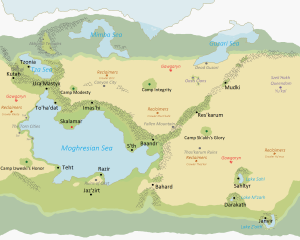
Marriage and Relationships
Relationships for Unathi hinge on responsibility for both involved as most marriages before the Contact War relied on clan leaders arranging marriages to secure alliances. 'Dating' has only recently been available to young Unathi and is a foreign concept to most above their late-20's in age. A Unathi trying to ignore the ritual of arranged marriage is a great insult to both clans involved, which at worst could lead to a blood feud or war.
Clan alliances are formed when two clan leaders mutually decide upon two Unathi to marry and, depending on who is chosen, certain gifts are expected to be bestowed on the allied clans. When the marriage is proposed, a discussion about which Clan Name will be taken arises. This is done through a form of 'bidding war', where one clan must "buy" the right to keeping the name over the other by giving money or resources to the other clan. Marriages may sometimes end up canceled due to both sides refusing to give up their clan name, and in the worst cases, it has led to duels or even wars fought over who has the right to keep the titles.
Surrogates can be called upon for a marriage that cannot fulfill their duty to have children; however, they must be from a member of one of the Clans. Upon the hatching of a hatchling, the expectation most often is that husbands will raise the boys, and wives will raise the girls. If there is only a husband or wife, more traditional Sk'akh families will choose to have another Clan member raise the hatchling up through their expected path.
Outside of the Hegemony's influence, same-sex relationships are generally not condoned; survival is an important factor in the Wasteland and on budding colonies, so blocking out the means to reproduce and continue a clan's lineage is heavily frowned upon.
Ouerean
While the Izweski Unathi of Ouerea follow most of the same social beliefs as their Moghean counterparts, they tend to be less volatile towards outsiders who are ignorant of their customs, especially since their world was formerly ruled by the Skrell and Humans. Their cultures have managed to influence Ouerean Unathi, embedding different cultural norms that are not found elsewhere. There is a focus on individualism and younger Unathi shy away from the usual responsibilities held to Unathi toward their clans. There is still a struggle with a highly stratified society, but things are moderately progressive compared to Moghes.
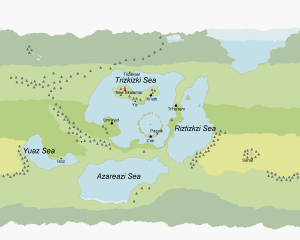
The original colonists started as patriots to the Izweski Hegemony, but many soon found themselves disillusioned with the distant homeworld tearing itself apart in war. Unathi on Ouerea became enamored with the broad ideals of democracy and finding themselves resentful of their old lives on Moghes. Reintegration into the Hegemony proved difficult as both planets had to reconcile these cultural differences. It still remains a minor division among these Unathi to this day.
Ouerean art, in contrast to Moghean pottery and dyed fabrics, has taken on inspiration from Human and Skrell art. Many Ouerean unathi have become renowned glassmakers and craftsmen. The greater access to Human and Skrell universities, many of which still operate on the planet, also give Ouerean Unathi greater chances to work in Human and Skrell systems.
Non-Izweski Unathi
Unathi of the Hegemony’s territories — the Izweski Hegemony itself, Ouerea, or any of its many colonies — require consent from their clan Lord to make their way out into the greater galaxy, as listed here.
Those that come from outside of the Hegemony and Dominia usually have no official means of recognized citizenship. Wastelanders, privateers, Guwan, and other Unathi must apply for a work visa where they are traveling in order to reside there. This of course carries risks with it: if a Unathi is seen as being problematic, whether committing crimes and misdemeanors or just not living up to the job they’re working, they may have their visa stripped and end up deported to the Hegemony. The Izweski Hegemony does not explicitly ask for these Unathi, especially seeing how they are usually 'undesirable'. As there are no officially recognized governments on Moghes besides the Izweski, however, deported persons get sent there. Guwan and Gawgaryn that manage to make their way out of the system to places such as Biesel will face harsh punishment if this happens, so they are the most incentivized to put on their best outward face.
The Zandiziite Games
An ancient sport that got its start on Moghes, this sport is best described as a mixture of Olympic- and MMA-style games. Competitors within the Zandiziite Games are called Zandiziites, or colloquially an individual wrestler is called a Zandi. Clans send eligible men (and only men) to their Lord in the hopes that they are chosen to represent their city or community in the Zandiziite Games.
A more in-depth description can be found here.
Unathi Physiognomy
Khaniazwazi, also known as Unathi Physiognomy to outsiders, is a science dedicated to the study of Unathi physical profiles and the deduction of their character from such things.While certainly not new in Unathi history, it has been going through a rebirth in popularity as more resources have been dedicated to the study of Unathi biology and it’s appearance, to make up for what was lost with the Contact War.
The validity of such a science is discussed, even among strictly professional fields, and it is no surprise that many individuals and groups have been using this field as a pretext to discriminate against other Sinta, or as a way to make a quick buck from more naive Unathi. Putting these aside however, there are still many variants of Khaniazwazi being practiced, depending of the area, with different interpretations of physical attributes. Generally, however, Khaniazwazi takes into account scale coloration, horns, frills, crests and facial structure; and in some rarer cases, smaller details such as wrinkles, scars, etcetera.
Politics
Moghes is divided between the Izweski Nation, which exists in the Untouched Lands, and the hundreds of other Clans and nations who claim their own land across the planet's surface. The only real difference in their political systems is the scale. Many of these other clans are modern nations or pre-industrial, ruled by various kings or leaders. However with the expansion of the uninhabitable Wasteland and the brutal decimation Izweski forces committed on foreign leadership many institutions of Non-Hegemony government across Moghes are rare or extremely fragile.

Izweski Nation
- "Honor, Fire, Burn thy Fear" - Izweski Ancestral Words, dating back more than 500 years
The Izweski Clan is lead by Clan Leader Not'zar Izweski, a Unathi who has ruled the Hegemony since his father S'kresti Izweski, the previous Hegemon, was assassinated by his son and Not'zar's brother. He lives in the Izweski Citadel in Skalamar, and under him are the Lords who rule their own subjugated clans. They live in a feudal system, with the Lords usually being clan leaders or important clan members themselves who pledge themselves to Izweski in exchange for land and protection.
The Hegemon is best thought of being the Emperor, and under him are the Overlords, who are the Kings. Under the Overlords are the Lords, who are then broken up between the Clan Lords, and then the Clan Leaders. Clan Leaders are a mostly ceremonial title and make up (usually) the eldest male ruler of a specific family clan.
Not'zar's father, Hegemon S'kresti Izweski, was originally a strong leader of the Izweski clan. Then, after the death of his eldest son in a shuttle crash, the old Hegemon fell into a deep depression, to the point of becoming comatose in the Izweski citadel. After a succession crises, Not'zar took his place as the Regent and heir for three years, over that time developing the Hegemony into a stable empire.
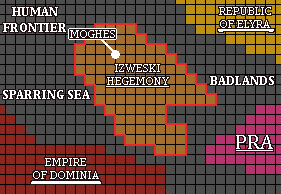
Three years later, the Hegemon awoke and took back to the throne, however on his tour to get reacquainted with everything, he was spurred into madness and cursed by Juzida Si'akh which resulted in a civil war to dispute his claim to the throne. In an attempt to destroy his enemies, the old Hegemon attempted to orbitally bombard an enemy city. To stop this dishonorable act, his third son Z'krazi Izweski the Kinslayer assassinated the Hegemon, and after Not'zar's victory in the Battle of Three Hills the civil war ended.
Now, Not'zar is the Clan Leader, Overlord of Moghes, and Hegemon of the Izweski Hegemony. Despite his severe physical handicap forcing him to walk with a cane, many noblemen have made him an ally, especially including the Guilds who enjoy his globalist attitude.
Overlords rule an entire planet in the name of the Hegemon. Under them are Lords, who can rule huge tracts of land and multiple cities, or just a single city; there is no distinction between a Count and Duke level of Lordship like in most human feudalism.
There are two different kind of major lifestyles In Izweski. There is the city, which is ran by a Lord and a small council of lesser clans. City life is less harsh than life in the country, especially with opportunities provided with shuttle services to the rest of the galaxy. Life in the rural areas is harsher, with cities being rare and life mostly determined by the size of a Clan's village and how well they can hunt, fish, or in desperate times, raid their neighbors. It's the traditional Unathi life, made harsher by the growing Wasteland encroaching on once-fertile lands.
Hegemonic Colonies
The Hegemony has several colonies as its empire begins to expand. Of these colonies, there are a few Notable Unathi Colonies.
Hands of the Lord
A wise ruler knows where he is lacking wisdom and hires an expert to consult him. It is this idea that led to the formation of Hands of the Lord, a fixture in the world of ruling nobility. Theoretically, the Hands of the Lord supplement lackluster skills a ruler may have and offer an expert perspective on issues. In reality, the Hands of the Lord are merely a vessel for which the powerful under the ruling nobility can gain influence and be encouraged to use it for the betterment of the realm and themselves. It is seen as a high honor to be appointed as one of the Lords Hands— both for an individual and for their whole clan. Hands of the Lord will be called "Hand of the [Title of their lord]" for example, Not'zars hands are called the Hands of the Hegemon.
The Master of Rivers
In charge of overseeing the economic aspects of a lord's land, the Master of Rivers reads aquaculture and fishery reports, negotiates with guilds, and safeguards the money that continues to flow into the coffers of the realm. The Masters of Rivers are arguably one of the most important Sinta in a realm with their control of the most precious resource of all, the treasure and food. Despite this importance, they are normally not of the same clan as the ruler. They are usually from clans which have a heavy hand in the industry or food production of the realm, whether it be aquaculture, or heavy industry. This is viewed by most lords as a concession to their skilled workers and is always a point of pride for a clan if one of their own is selected. Gender does not matter for the title, though they tend to be predominantly male anyway.
The Lord’s Claws
The Lord’s Claws is a Lord’s Hand who is well versed in military matters, offering strategic advice to their lord. Lord’s Claws are most commonly a part of the same clan as their lord, if not they are married to a suitable clan member as quickly as possible, and brought into the fold. Due to the militaristic nature of many Unathi realms pre-Contact, a clan survived or died by the sword, and advice on military matters needed to be untainted by potential corruption and trusted beyond doubt. The not-so hidden message in marrying the Lord’s Claws into the clan was that if the clan failed in war, he would be executed along with all the other members who could not escape. However,a Lord's Claws has not only the job to help their lord fight wars, but also to prevent them from starting. Nearly all Unathi lords still follow the tradition of having their Claws conduct diplomacy in their name, striking agreements with rival clans and lords, warding off the red tides of bloodshed for as long as possible. There are no female Unathi of this title in the Hegemony.
Spymaster
A coveted position amongst women in the Hegemony, the Spymaster is a spider spinning and untangling webs of secrets and intrigue, safeguarding their lord both against scandal, and assisnation. Spymasters also keep tabs on the local population for their lord, silencing dissent and ensuring loyalty. Lies, plots, and secrets are the bread and butter of spymasters, and those who have mastered the position are viewed by others with a certain weariness, afraid they might turn on them one day. Spymasters within the Hegemony are only women.
Court Shaman
A position originally started by the more political Sk’akh religion, it has since been adopted by Th’akh nobles as well. The primary responsibility of the court priest is to offer spiritual advice to their lord and to cement the political and cultural importance of religion. Secondarily, Court Priests have a duty to help the faithful bring their grievances to their lord and tend to the connection between the ruling nobility and their subjects. People in this position tend to be men, though Th’akh’s adoption of the practice, as well as the rare female Priest of the Aspect, has seen some women participating in the role
High Speaker
A newer position, the High Speaker's primary job is to work in the noisy and complex world of public relations for their noble. Very few ruling nobles have a High Speaker as one of their Hands, either relying on their spymaster for knowledge of what others think of them, or do not deem public relations as important to their management of their lands. Rulers who choose to incorporate a High Speaker as one of their hands tend to be more predominant within their larger realm, such as one of the two Overlords within the Hegemony, or have lands whose industry relies heavily on skilled guildsmen who cannot be ordered around as simply as peasants. Gender does not matter for high speakers, and few nobles even have an alien high speaker should their realm have a heavy mega corporate presence.
Surviving Kingdoms on Moghes
Despite the destruction of most of the known world from the Contact War, some desperate survivors managed to weather the storm and remain nominally free of Izweski dominance - either from the Izweski's weariness for war on Moghes, or arrogant indifference.
While the Izweski are reclaiming the Wasteland, they are ruthlessly uprooting and displacing local cultures in the remaining habitable lands. The Outposts were small, fertile enclaves that survived the Contact War surrounded by the Wasteland. Starting in 2461, Not'zar pushed forward terraforming efforts to expand these green yet hostile oasis.
Queendom of Szek’Hakh
- "Refuse To Break" - Szek'Hakh clan motto, before the war
A matriarchal region of roughly twenty thousand set in the Wasteland, led by the elderly Queen Lazak Szek'Hakh and her daughters. In her settlement and a large portion of the region surrounding it, her clan has become the protector of her region known as the 'Queendom'.
For those living in the Queendom, the gender roles of Unathi are inverted, and many of its people thusly struggle to find opportunities on Moghes and seek employment in Tau Ceti - with the Queen even making connections with pirates, Dominians, and Tajaran smugglers to get her people safely out of the dangerous Wasteland. The Queen is kind under her witty and straightforward attitude, and despite stereotypes, does not actually hate men.
The Szek'Hakh clan's settlement of Yu'kal, originally headed by the Queen's husband, was built around a cluster of small lakes and focused on aquaculture. When the Contact War's nukes wiped out the vast majority of men, they adapted to using women as protectors, while using men to keep house. The widowed Lazak Szek’Hakh convinced the shell-shocked and wounded survivors of her clan that she was the only one capable of ruling during this terrifying time, and had taken control of a sizable region of the Wasteland east of Mudki around Yu'kal.
The Szek'Hakh Clan became the leading power in their region following the Contact War. Eventually, Szek’Hakh consolidated control of her clan and the settlement, taking matters of survival into her own hands. As the Wasteland engulfed Yu'kal's lakes, she coordinated a renovation of aquaculture farms and lead expeditions to bring their highly valuable fish products to the distant surviving city of Mudki. Women took prominent roles in all of these, with the necessities of survival in the harsh wasteland fraying Unathite gender roles. A neighboring nobleman, fearing this rise of powerful women, orchestrated to have her assassinated. In a dramatic confrontation, the assassin was foiled and publicly exiled as a Guwandi, and a mob of angry women stormed the nobleman's estate to 'duel him for his dishonor'. This act put the matriarch in the spotlight, sparking Szek’Hakh’s rapid rise of being named Queen by her people.
Queen Szek’Hakh now leads a struggling wasteland settlement in a precarious situation. The traditional Izweski-leaning Unathi find her position an affront to customs, and she struggles to find allies. She tries to walk a delicate tightrope balancing the relations of the Sk’akh Church, the Izweski, and the Wastelander factions - however she is often too straightforward to get far. Her settlement is primarily Th’akh, and she herself follows the faith. She complies (though unwillingly) with the demands of Izweski representatives to expel the prophet Si'akh from her realm when he enters her settlement in his travels, though she quietly allows members of his traveling flock to rest in secret when they pass through her settlement. For the same, she does not tolerate the cult of the Aut'akh, and her people ruthlessly hunt down their unaugmented proselytizers.
History
More in-depth information on the history of the Unathi can be found on their history section.
The history of the Unathi is predominately a history of each Hegemony that has existed throughout their history. There have only been three clans that have managed to create an empire worthy of the title 'Hegemon.'
The Kres’ha’nor Hegemony lasted from roughly 920 CE - 1500 CE Galactic Standard Time. It is most famous for being the first empire to dominate Moghes and creating what was then a modern feudal state. Their empire saw rise of walled cities, steel weapons, centralized taxation, and other innovations. It ended in a brutal succession war, with Moghes once again being shattered into hundreds of individual Kingdoms with no true global power.
In the 16th century the power of Guilds began to grow, forming an early form of mercantalism. Guilds formed for bakers, butchers, grocers, millers, smiths, carpenters, weavers, mason, shoemakers, in fact, nearly every trade had its own guild. Standards such as just weights and measures evolved from the guilds, and guild inspectors would inspect shops to ensure rules were being followed. Guilds would help members that were sick, or in trouble, and would sometimes take care of families after the member died. This time also saw Guilds building the first major universities. While incredibly exclusive, these universities began to create a new era of specialized labor and intellectuals.
The 19th century saw rise of the Second Hegemony, ruled by the Sarakas Clan. Their clan ruled harshly, and forced technological advances into the cities and towns. In the 1930's they ruthlessly modernized their empire in The Great Endevour, spreading electricity, radio, paved roads, modern plumbing, and other modern innovations.
In 1994 the Izweski Clan violently deposed the Sarakas and slaughtered the entire surviving dynasty, declaring the Third Hegemony. After they won an incredibly destructive global war to defend their claim, the Izweski have ruled Moghes until modern times.
In 2433, a human exploration team discovered Moghes. Shortly after, first contact with the Izweski Hegemony was made. Sol Alliance merchants and scientists flocked to Moghes, living under very careful observation and guard in Izweski cities. Skalamar, the second largest city in Izweski, became the first Unathite city to have a shuttle port constructed. Owned by NanoTrasen, it served to transport people to and from the planet’s surface.
The Contact War, which has more information here, was a cataclysmic global war that lasted from 2437 to 2449. The fighting was between two global powers, the Izweski Hegemony, and the Traditionalist Coalition. The war was fought over the very future of the Unathi and their relationship with the rest of the galaxy. The Izweski demanded Moghes submit to a one-world government ran by themselves and embrace the influence of humanity. The Traditionalist Coalition rejected this. The war went nuclear on September 5th, 2439, causing immense suffering across Moghes and directly leading to the creation of The Wasteland, which is set to engulf Moghes within a hundred years.
Notable Information
The Guwandi
In the event that a Unathi becomes terminally ill, or finds themselves lacking the pride or honor to continue to live, or simply become tired of their existence undergo a ritualistic suicide and take the title of 'Guwandi' (which is translated to Gladiator/Galdium). They will give up their possessions to their clan leader and make their journey into the Moghes desert. The only things they keep are their weapons which they use to fight animals or other Unathi so that they may die in honorable combat. In the event that two of these Guwandi meet, they will first draw their weapons and adopt a passive stance, which is followed by them telling each other their stories in turn, as well as the reasons behind their choice of adopting the mantle of 'Guwandi' and how they wish their remains to be dealt with. When both sides understand the other, combat will begin with a mutual wish of luck that the more worthy of death lose with pride. The winner of the battle is responsible for taking care of the corpse in the way they were instructed to. Renouncing the deathseeking life of Guwandi isn't easy. Some may wish to return after having been granted a second outlook, or hope, after they had spent time wandering and risking their life. Their clan may see their decision as cowardly and refuse to accept them, or be overjoyed they had learned a lesson in their time.
Guwandi are not an option on station, yet may be a way in which a character becomes retired, barring extreme circumstances.
The Guwan
In some cases when a Unathi is exiled from their clan, they do not take up the formal title of Guwandi. This can be through fear of death, unwillingness, or simple stubbornness. In this case, they are marked as 'Guwan' by their clan leader, and must take this as their last name. It is a variation on Guwandi, which is translated directly as 'exile'. Guwans are clanless Unathi, and form an underclass. Guwans find it difficult if not impossible to advance socially or politically, and in many cases are oppressed or mistreated by other Unathi who view them as troublemakers or criminals. The only way of returning to a clan after banishment as a Guwan is to be adopted back into the Clan, which happens very rarely. To no longer be a Guwan, a Unathi must have an upstanding citizen decide to represent them, and then they must both go to court to explain how the Guwan can return into society under a new clan name, be adopted into another clan, or return to their original clan (at Clan Leader's acceptance.)
On August 29th, 2459, the Lord-Regent Not'zar Izweski passed an edict that required clans to send a petition to an imperial court when they want to banish a clan member as a Guwan. The court must side with the petitioning Clan Leader or the Unathi in question is not marked as a Guwan. This has caused backlash as the courts have gained a reputation for being incredibly arbitrary in their decisions.
In the past, all orphans were automatically Guwan unless they are adopted into a Clan. This changed with yet another edict by Not'zar Izweski in December of 2459, which required all orphans, including adults still connected to their orphanage guild via debts or otherwise without parents, to take on the surname of that orphanage.
Some Guwans have been forced off of Moghes by their clans with the growing ease of space travel, and NanoTrasen has a long history of exploiting this subgroup of Unathi, coercing them into employment contracts.
Guwans are not permitted to petition their local Lords to express any grievances, and are not permitted to social services provided by private enterprise or state entities. They are not full citizens of the Hegemony but are considered residents, which additionally bares them from many services.
Notably, Guwans are the only social class of Unathi allowed to serve in the personal guard of the Hegemon and his family. The strategy relies on the fact the Guwan Guard are despised and envied by decorated officers that would otherwise serve in traditional guard duties. They are socially isolated and unable to advance politically, which means that their survival depends on the safety of the Hegemon and his family, which means that they wouldn't try to launch a coup or replace the Hegemon without themselves being slaughtered. Similar to an old-Terran Janissary, they're a slave soldier, and unable to have children or hold any sort of political or military position.
If a Unathi is the last of their clan, or is otherwise estranged with no one to declare them Guwan, then they may still find themselves challenged by other rival clans who lay claim to this Unathi's land, titles, inheritance, or name. If they are unable or unwilling to defend their claims (which would involve lengthy court trials on Moghes) then they would be stripped of them and declared Guwan. This means that a Unathi hiding in human space can still be named Guwan if their past, or rivals, catch up with them.
Guwans are exclusively a criminal or otherwise dishonorable untouchable class, and it takes a lot to be labelled as one. Because playing a Guwan means you are opting in to being discriminated against by others, a Guwan filing an incident report for anything less than physical assault is a whitelist issue. When in doubt, speak to the Maintainer first.
Orphans and Orphanage Guilds
Orphans in the Hegemony in the past were all labelled as Guwans, but an edict by Not'zar Izweski in December of 2459 changed all that. Hatchlings, child, and teenage Unathi without parents are put in the care of one of the many orphanage guilds on Moghes. These are private run guilds with little to no government oversight. While they fulfill a necessary social service in caring for Unathi that would otherwise be on the streets, orphanage guilds in the Hegemony are incredibly exploitative. Unknown to the children the guilds track all the expenses and charge their wards throughout their life until they turn 17, when they are presented with the bill and are forced to work to repay the crippling debt, and many can be trapped by the fact that their debt would fall on any prospective parents.
Two of these guilds have expanded into large corporations that have found a lucrative method of gaining money from their wards. The Gukuzan and Kuhwinla Guilds coerce or persuade their wards to accepts contracts for NanoTrasen if they reach adulthood without being adopted.
The Gukuzan clan is lead by a Priest Kiazoi, and he ensures that those that enter the care of his guild are given a proper religious education and instilled with the values of the church. Children raised by the Gukuzan are also taught valuable lessons in obedience and the importance of duty and respect to their betters. Its wards are moderately well-off and treated well, but the comforts of a happy childhood in the orphanage is rather soured by the fact everything from bedding, food, and even air conditioning are things each child has added to their growing debt. Gukuzan orphanages are scattered across Moghes and there are three on Ouerea. They are all exclusively managed by a priest on the payroll of the Gukuzan.
The Kuhwinla clan is lead by Guildmaster Ioaza Kuhwinla, an infamously frugal woman. She refuses to spend any more than she has to on her wards, meaning that those under her care are given the most basic of education. Children raised by her Guild are taught valuable lessons in thrift, obedience, and how to stretch meals to the absolute limit. Its wards are generally barely better than they would be on the street, but they live with a roof over their heads, semi-reliable food, a basic education, and their debt at the end of their life under the Kuhwinla is generally lower than it would be in other orphanages. Kuhwinla orphanages are in nearly every major Unathite city, and they are unique in that they are managed by matriarchs that answer to Ioaza.
These two surnames are the only ones you may take if you play an orphaned Izweski on the Aurora station!
Diet and Cuisine
Unathite dishes are mostly comprised of meat, eggs, and fish. It may be cooked or even still raw and bleeding. Vegetables in meals are often just for decoration or flavor, but by no means ever make up the majority of the dish. Unathi do not take any nutritional value from plant matter, only from meat. Desert flowers may also be placed on the plate to make it seem well-presented and are also edible. The tools Unathi use to eat are very unorthodox to humans, usually resembling chopsticks banded together near the top.
Unathi generally eat only one large meal a day. The nobility often eat twice a day, while poorer Unathi or those in the Wasteland will eat bi-daily: every two days.
To support their civilization, fishing has developed on a scale similar to human agriculture. Since the Contact War, fishing yields have fallen, and hunger has become a fact of life for many Unathi.
| Unathi Lore Pages | ||
|---|---|---|
| Planets and Systems | Moghes · Ouerea · Uueoa-Esa · Notable Unathi Colonies · Gakal'zaal · Tret | |
| Factions | Izweski Hegemony · Unathi Guilds · Unathi Piracy · K'lax in the Izweski Nation · The Queendom of Sezk-Hakh · Free City of Vezdukh · Unathi in Dominia | |
| History | Unathi History · Contact War · Unathi Recent Events · Notable Unathi | |
| Religions | Sk'akh · Th'akh · Aut'akh · Si'akh | |
| Society and Culture | Unathi Entertainment · Unathi Honor · Unathi Military Structure · Unathi Crime And Enforcement · Unathi Educational Institutions · Unathi Spaceflight · Unathi Abroad · Zandiziite Games | |
| Regions of Moghes | Izweski Heartland · Tza Prairie · Southlands · Broken Coalition · Torn Cities · Zazalai Mountains · The Wasteland | |
| Lore Arcs | The Titan Rises Arc | |







